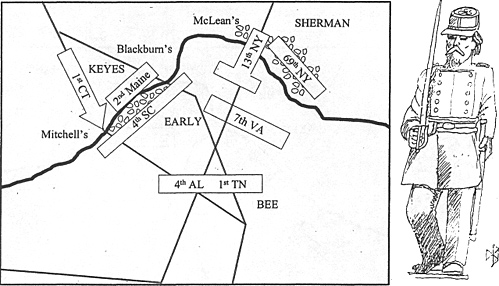 Beauregard and Joe Johnston alerted to the gunfire simultaneously. Seated on their horses along the Orange & Alexandria Railroad, they looked immediately to the northeast. "Sounds like it's coming from near McLean's Ford," stated Beauregard emotionlessly. Johnston nodded. "Well, it's begun. Those Yankees been dawdling near Centreville for days. Now's our chance to push them back to Washington." The gunfire was punctuated at intervals by a single cannon shot.
Beauregard and Joe Johnston alerted to the gunfire simultaneously. Seated on their horses along the Orange & Alexandria Railroad, they looked immediately to the northeast. "Sounds like it's coming from near McLean's Ford," stated Beauregard emotionlessly. Johnston nodded. "Well, it's begun. Those Yankees been dawdling near Centreville for days. Now's our chance to push them back to Washington." The gunfire was punctuated at intervals by a single cannon shot.
After several minutes a courier appeared, riding his horse for all it was worth; "General Beauregard," he stammered as he rode up. Saluting, he nearly yelled. "Sir, Colonel Early sends his regards and states that the Yankees are trying to cross McLean's Ford." He paused to gulp fresh air into his aching lungs. "Take it easy, son. How many Yankees?" asked Johnston. "Well, I don't know," replied the courier. "Can Colonel Early hold them or does he ask for assistance?" continued Johnston. "Well, General Johnston, I don't rightly know that either," said the courier in a much more subdued voice. Beauregard added, "Then please return my regards to Colonel Early and tell him that I will be by shortly to see the situation for myself." The embarrassed rider saluted quickly and sped back to the front, happy to be away from the hard questions. "It is just the nervousness of his first fight," said Beauregard. "He will get better as he sees more war." "They all will," replied Johnston softly, "They all will."
Colonel Jubal Early was anxious to fight. Beauregard gave him three critical crossing sites to defend: Mitchell's, Blackburn's, and McLean's Fords. Early gave the 4th South Carolina the task of covering both Mitchell's and Blackburn's Fords while the smaller 7th Virginia guarded McLean's. Early had a four-gun battery of 12 pound guns. However, the approaches to the Ford's were quite"narrow. He managed to get two guns on the trail leading to McLean's Ford so that he could fire on the enemy just after they exited the crossing site. There were no comparable positions for cannon at the other two fords so Early kept the last two guns toward the rear where they would be in general support of the brigade.
There was a stand of thick woods on the Yankee side of Bull Run around McLean's Ford. Colonel William Tecumseh Sherman led his men, the 13th and 69th New York, right up to the creek without being detected. He placed the 69th and a single gun in the woods to support the crossing, formed the 13th into a column as wide as the ford, and gave the order to cross.
The men of the 13th stormed down the path leading to the creek and started across the thigh-deep water. Of course, the soldiers in the water could not cross as fast as the soldiers on the path behind them could move. The result was bunching up and confusion at the water's edge. As the Yankees got about half way into the ford, the confederates on the opposite shore from the 7th Virginia opened a sporadic fire that was returned in force by the 69th New York. The volume of fire picked up as more confederates got into the fight. Yankees started dropping in the water, making it difficult for those behind them to continue. Nonetheless, the Yankees pushed across the water and the survivors of the lead company started up the path into a clearing. There, they were startled by the sight of Virginians forming up in a firing line to oppose them. All at once, the pair of rebel guns opened fire with canister and wiped away the first comany of the 13th New York. Sherman, himself in the water, ordered the colonel of the 13th New York to form his men into a firing line as soon as they exited the ford and to return the rebel musket fire.
Jubal Early shifted companies from the 4th South Carolina to support the 7th Virginia. The men of the 13th New York concentrated their fire on the gunners of the artillery battery only a hundred yards away and slow down the rate of fire of the deadly cannon. Despite casualties, more men of the 13th get across and strengthen the firing line. The 7th Virginia, receiving a tremendous volume of fire from the woods across Bull Run, is slowly forced backward despite Early's frantic pleas to hold its ground. Just then Beauregard arrives, sizes up the situation, and orders Early to back up a hundred yards, out of range of the Yankees across the creek, but still postured to defend against the crossing enemy. Reluctantly Early agrees and orders his guns to limber and to follow him as he charges off to select new gun positions. Once Beauregard reassures Early that help is on the way, Early orders the 4th South Carolina back into its original positions and directs the withdrawal of the Virginians to a line on either side of the artillery pieces. Early is determined to hold on until help arrives.
Beauregard returns to Johnston's headquarters and the two confederate commanders confer. As Beauregard relates the serious nature of the threat posed by the federals crossing at McLean's Ford, they hear a sudden increase in firing coming from the left of Early's fight. Johnston sends a courier riding to General Bernard Bee with orders to proceed immediately toward Early's position and support him there. Beauregard rides off again toward the sound of the new firing to see for himself what is going on. Johnston rides over to General Thomas Jackson's Virginian brigade to ensure that they are ready to move on a moment's notice.
The gunfire the two confederate generals heard was the result of Colonel Erasmus Keyes's Brigade arriving at Mitchell's Ford. Keyes formed the 2nd Maine into a firing line and moved them nearly up to the edge of Bull Run before the 4th South Carolina, just returned to their positions, opened fire. This time the confederates had the advantage of protection from the woods. However, the South Carolinians had to divide their fire between the Maine troops and the 1st Connecticut, which was heading briskly into the ford and emerging from the southern bank. The Connecticut troops had an advantage in that Bull Run had steep banks at this ford and they were covered from the confederate fire until they climbed up the banks.
The fight was desperate on both sides. Keyes and Sherman managed to keep troops crossing the fords and superior firepower was slowly eroding the fighting strength of Early's men. Sherman got his battery of six guns across McLean's Ford and up on line with the 13th New York. As the weight of grapeshot penetrated Early's lines, his Virginians recoiled about fifty yards before Early could steady them once more. Bee brought the 4th Alabama and a battery of guns to fill the gap between Early's dwindling regiments. Bee directed the Tennesseans to back up the three regiments to their front. Smoke filled the air. The walking wounded emerged out of the smoke and into view of the 1st Tennessee, causing some men to break out into a heavy sweat, and others to vomit. The colonel of the 1st Tennessee rode back and forth along his lines steadying his men for the fight that would soon pass to them.
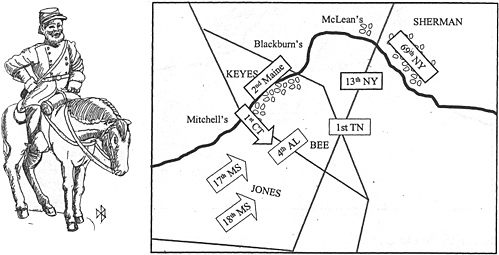 Meanwhile, miles away at Sudley Ford, General Louis Blenker ordered his federal troops to cross into rebel territory. There were no confederates there to oppose him. Slowly, company after company of New Yorkers and Pennsylvanians crossed Bull Run and formed up on the opposite shore.
Meanwhile, miles away at Sudley Ford, General Louis Blenker ordered his federal troops to cross into rebel territory. There were no confederates there to oppose him. Slowly, company after company of New Yorkers and Pennsylvanians crossed Bull Run and formed up on the opposite shore.
Seeing the fight going poorly at Mitchell's and McLean's Fords, Beauregard decided to order General David R. Jones to move his brigade of Mississippians to support Early and Bee. This decision came none too soon as Early's men were at the breaking point. A carefully aimed rifle shot tumbled Early from his horse as the confederate general was exhorting his men to stand firm. Seeing their leader fall was too much for the Virginians who started melting away; men in small groups or singly withdrawing through the smoke. seeking safety. They had done all they could.
At Mitchell's Ford, Yankee firepower was having a similar effect on the South Carolina troops who very slowly gave up ground, falling back and through Bee's Alabamans. Bee ordered the Tennessee regiment onto the right of the Alabama boys as Jones men were seen arriving on their left. Even without Early, Bee was determined to resist. He sent a messenger off to find Johnston and to ask for assistance. Arriving on the scene, Jones saw an opportunity to deliver a decisive attack upon the Connecticut troops who were pressing Bee's Alabamans. Unfortunately, try as he would, he could not get the poorly trained 17th Mississippi to form from column to line to deliver the assault. Jones frustration was evident as he screamed at the poor regimental colonel. Slowly, the federals were advancing and Bee's men were giving up ground. The 1st Connecticut delivered a murderous volley into the Alabamans who fell back out of range. Many Alabamans grabbed their wounded comrades and pulled them to safety. Reacting quickly, the Connecticut colonel ordered four companies to form line and deliver a series of volleys on Jones's Mississippians who were still trying to form line themselves. In the confusion of receiving fire while changing formation, the 17th Mississippi staggered into chaos and Jones and his officers worked hard to reestablish order.
Fortunately for the confederates, Joe Johnston ordered Jackson to support Bee with his brigade of Virginians. What none of the confederate commanders knew was that two fresh Yankee brigades were fast approaching Bull Run. Colonel Andrew Porter's New York Brigade, marching in column, was closing quickly on McLean's Ford while Colonel Thomas Davies' brigade of New Yorkers headed for Blackburn's Ford. The saving grace for the Southerners was the long time required to pass a regiment over a ford and to form up on the opposite shore. Yankees were crowding at the crossing sites but only a few could cross at a time. Thomas Jackson was unaware of the'large number of Yankees still on the other side of Bull Run. Had he known, it still would not have affected his decision. Jackson ordered his two regimental commanders to his side. "We attack immediately. The 2nd Virginia will lead the attack. The 5th Virginia follows at one hundred yards and supports." The Virginian colonels saluted their general, returned to their respective regiments, and began the slow process of forming the men into the prescribed attack formation.
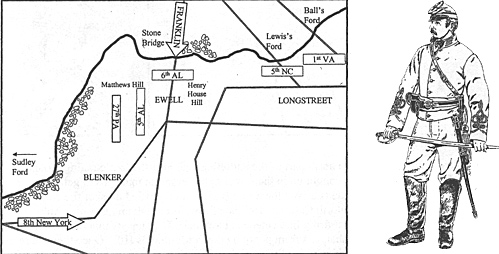 Meanwhile, a couple miles to the north, another fight was shaping up. General Louis Blenker got all his troops across Sudley Ford. The 27th Pennsylvania was well in the lead and was fnrmine un on Matthews Hill. ready to push on to Henry House Hill. The 8th New York, which had just completed crossing the ford, was still moving in column to catch up with the Pennsylvanians. Ewell, seeing this threat to his command, swung the 5th Alabama around to protect his left and kept the 6th Alabama focused on defending the Stone Bridge. Ewell sent a courier to General James Longstreet at Lewis's and Ball's Ford, alerting him to the threat on their left. But no sooner did the courier gallop off than Ewell's lookouts reported a cloud of dust moving toward the Stone Bridge. In that cloud of dust marched General William B. Franklin's Brigade composed of the 5d' and 11th Massachusetts. Things were heating up rapidly.
Meanwhile, a couple miles to the north, another fight was shaping up. General Louis Blenker got all his troops across Sudley Ford. The 27th Pennsylvania was well in the lead and was fnrmine un on Matthews Hill. ready to push on to Henry House Hill. The 8th New York, which had just completed crossing the ford, was still moving in column to catch up with the Pennsylvanians. Ewell, seeing this threat to his command, swung the 5th Alabama around to protect his left and kept the 6th Alabama focused on defending the Stone Bridge. Ewell sent a courier to General James Longstreet at Lewis's and Ball's Ford, alerting him to the threat on their left. But no sooner did the courier gallop off than Ewell's lookouts reported a cloud of dust moving toward the Stone Bridge. In that cloud of dust marched General William B. Franklin's Brigade composed of the 5d' and 11th Massachusetts. Things were heating up rapidly.
Longstreet received the message from Ewell at about the same time his own scouts reported a large body of troops approaching Stone Bridge. Putting the pieces together, Longstreet realized that Ewell was in serious trouble. Ewell and the entire confederate left flank would be turned if something was not done in a hurry. Longstreet sent for his regimental commanders. When each reported that there was no activity to their front, Longstreet ordered the 5th North Carolina to head toward Henry House Hill to support Ewell. He ordered the lSt Virginia to form in two battalions, sending one battalion to occupy the positions vacated by the North Carolinians. As an afterthought, James Longstreet sent an aide to find Beauregard and to explain the situation. Longstreet expected Beauregard to be tied up with the fight on the right flank and he was correct.
The battle on the confederate left was growing increasingly intense and regimental commanders on both sides were frustrated in their attempts to get their men formed up or to deliver critical attacks. Guns on both sides opened holes in the opposing lines with canister and grape. Jackson's intrepid gunners delivered a powerful counter-battery punch to Keye's guns, knocking three of them out of the fight. But numbers count and more union troops began arriving. General Oliver O. Howard's Brigade of the 3rd and 4th Maine and a battery of guns appeared at Mitchell's Ford just as Keyes got the last of his men across that narrow crossing. Shortly afterwards, General Robert C. Schenk's Ohio brigade found itself waiting for Porter's troops to cross at McLean's.
The Union men east of Bull Run waited impatiently to cross the narrow water while those west of the river maintained a galling fire on the outnumbered confederates. Could rebel firepower keep the Yankees in place, keep them from crossing more men? Both Jackson and Jones struggled to get their men moving forward to attack but the raw soldiers, who had been civilians only weeks earlier, would not cooperate. Moving forward a yard or two, the men halted and could not be budged.
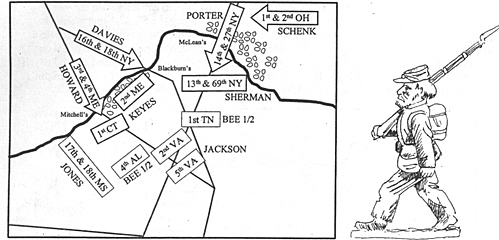 The Yankees and Rebels on the north part of the battlefield can hear the battle raging around the southern fords but they are too caught up in their own fight. Franklin manages to get five companies of the 5th Massachusetts across the Stone Bridge but the rifled musket fire from the 6th Alabama and Longstreet's 5th North Carolina decimate them, forcing them to recoil. Atop Matthew's hill, the 5th Alabama, firing like veterans, blow the 27th Pennsylvania off the hill. Ewell manages to keep the Alabamans from pursuing down Matthew's Hill. Once they are reset, Ewell gallops back to Stone Bridge to lend the weight of his physical presence. Longstreet, impatient and anxious to get in to the fight, leads the 1st Virginia across Lewis's Ford. Finding no signs of the enemy, he decides to attack into the eastern side of the Stone Bridge!- Moving quickly into the woods immediately south of the Stone Bridge, the 1st Virginia opens up a heavy fire into Franklin's exposed troops. The surprised Massachusetts men turn toward the fire and return it as best they can.
The Yankees and Rebels on the north part of the battlefield can hear the battle raging around the southern fords but they are too caught up in their own fight. Franklin manages to get five companies of the 5th Massachusetts across the Stone Bridge but the rifled musket fire from the 6th Alabama and Longstreet's 5th North Carolina decimate them, forcing them to recoil. Atop Matthew's hill, the 5th Alabama, firing like veterans, blow the 27th Pennsylvania off the hill. Ewell manages to keep the Alabamans from pursuing down Matthew's Hill. Once they are reset, Ewell gallops back to Stone Bridge to lend the weight of his physical presence. Longstreet, impatient and anxious to get in to the fight, leads the 1st Virginia across Lewis's Ford. Finding no signs of the enemy, he decides to attack into the eastern side of the Stone Bridge!- Moving quickly into the woods immediately south of the Stone Bridge, the 1st Virginia opens up a heavy fire into Franklin's exposed troops. The surprised Massachusetts men turn toward the fire and return it as best they can.
Seeing Longstreet's men on the opposite side of the Stone Bridge, Ewell decides to press the fight and he personally leads the 6t Alabama in an assault across the bridge and into Franklin's befuddled men. Franklin attempts to assault Longstreet's men in the woods but his troops are blown away by the intense fire. When Ewell's Alabamans storm across the bridge, they run headlong into the right flank of the Massachusetts soldiers who recoil. Thrown into confusion, Franklin orders his men to withdraw, hoping to find a secure position where he can restore order. Meanwhile, General Blenker tries in vain to rally his Pennsylvanians who retreat directly into the path of the 8th New York. The New Yorkers, who haven't fired a shot in anger, are panickstricken and join in the headlong dash back to Sudley Ford. Blenker, angrier than a wet cat, sputters and curses and chases after his men, ordering them in vain to stand and reform. The threat to the left of the confederate line is over.
Beauregard and Johnston, however, are too busy to enjoy the report from Ewell, announcing victory at Stone Bridge and Matthew's Hill. The rebels on the right are hard-pressed by the weight of the federal fires. Slowly but relentlessly, Bee's and Jackson's men are cut to ribbons. Sherman and Keyes' troops are likewise taking heavy casualties. However, numbers count. Three fresh Yankee brigades, those of Howard, Davies and Porter slowly cross the narrow creek which has been holding them up all day. These federal troops form up an extended line behind .the cover provided by their comrades in Sherman's and Keyes' Brigades. Schenk's Ohions begin the long process of crossing at McLean's Ford.
As both sides trade rifle volleys at close range, the crews of the cannon are either killed or forced to seek cover. Fewer and fewer cannon shots are heard. But a last round of canister from a lone Yankee gun catches Barnard Bee in front of his men who see his shattered body and that of his horse blown backward in the blast. Bee's men can take no more and they start falling back. Jackson's men hold firm for a moment but then begin an involuntary withdrawal. Thomas Jackson himself restores order to the 2"d Virginia but the 5th picks up speed as it moves rearward. Beauregard and Johnston yell themselves hoarse trying to stem the receding tide. It is at this very moment that Major General Irwin McDowell, who had spent most of the battle east of Bull Run sorting out the confusion on the roads leading to the fords, gallops across the rear of the union lines ordering one regiment after another to assault. The fresh troops from Maine and New York pass through the jaded troops of Keyes and Sherman. With their brigade commanders, Howard, Davies, and Porter, at their heads, the federals press the attack. Jackson and the 2nd Virginia, for a moment, hold fast but the Yankees numbers are too great.
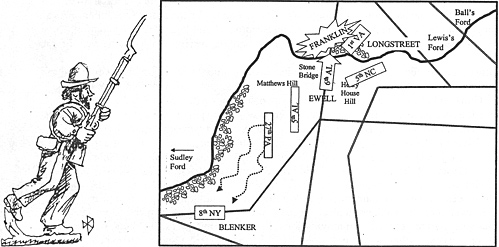 Johnston and Beauregard quickly confer. There is no hope left. Orders go out to Jones, Jackson, Ewell and Longstreet to withdraw toward Richmond. Somewhere, they are told, a new line will be established. For now, they must keep the army together and moving more quickly than the federals.
Johnston and Beauregard quickly confer. There is no hope left. Orders go out to Jones, Jackson, Ewell and Longstreet to withdraw toward Richmond. Somewhere, they are told, a new line will be established. For now, they must keep the army together and moving more quickly than the federals.
As the confederate commander, this battle was thrilling to fight. Until the last few turns, I had no idea how it would end. My success at Stone Bridge was exhilarating and I entertained the momentary hope of turning Ewell and Longstreet southward to influence the fight on the right of the line. I even considered crossing them all to the eastern side of Bull Run. But numbers and time and distance were against the rebs. The good news was that I had an enjoyable scenario and a workable set of rules. I believe I had introduced just the right blend of brittleness and confusion typical of formations hastily thrown together at the beginning of the American Civil War. And I had a mechanism to feed in Yankees at unexpected places and at random times. Now, I just have to paint up some more figures so I can field more and larger brigades!!!
Going It Alone: The Solo Wargamers Corner First Bull Run
-
Introduction
The Preliminaries
Orders of Battle: USA and CSA
The Battle
Solo Rules
Cohesion, Command, and Control
Order of Battle
The Desperate Struggle
Back to Table of Contents -- Lone Warrior # 142
Back to Lone Warrior List of Issues
Back to MagWeb Magazine List
© Copyright 2003 by Solo Wargamers Association.
This article appears in MagWeb.com (Magazine Web) on the Internet World Wide Web.
Other military history articles and gaming articles are available at http://www.magweb.com
